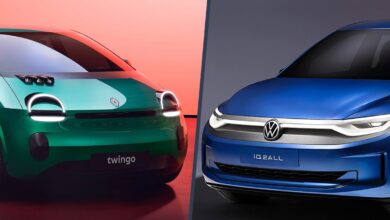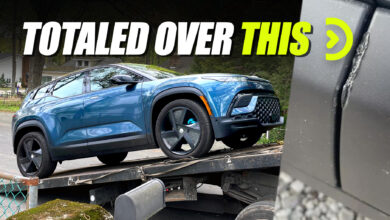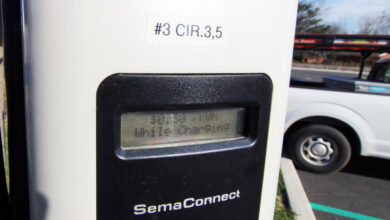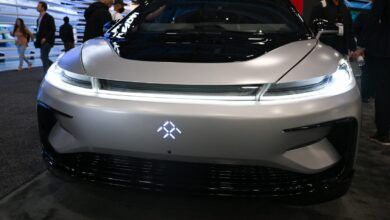Why The U.S. Government-Funded EV Charger Rollout Is Taking Forever

Where are all the EV chargers? Plus, we look at Ford’s unexpected boom in hybrid profits and more.
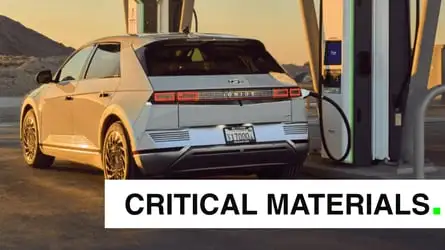
Let’s be clear about one thing: America’s public electric vehicle charger network is growing. Possibly not on pace with the growth of electric vehicles themselves, but it is getting there. Now, the U.S. government-funded National Electric Vehicle Infrastructure program meant to add high-speed chargers to highways across the country? That one’s taking a while, and we’re about to explore why.
Welcome to this Monday edition of Critical Materials, our morning roundup of the latest news in automotive tech, mobility and the future of driving. And welcome to June! Summer is here (people say it’s technically still spring, but I’m from Texas, so I can’t get my head around that idea) and the EV news is as hot as ever. Also on tap today: the auto industry takes on the state-by-state roadblocks to electric adoption, and Ford gets some wins on hybrids. Let’s dig in.
30%: Where Are All The NEVI EV Chargers?
When the Bipartisan Infrastructure Law was passed in 2021, it allocated $5 billion in grants to build fast-charging stations along highway corridors. The goal was to erase range anxiety from the Great American Road Trip and convince more drivers to go fully electric with their next car purchase.
It’s now mid-2024, and bad news, folks: only eight NEVI-funded charging stations are open, and only in six states, Automotive News reports.
Why is it such slow going to build these up when the EV charger market is still a red-hot one? According to pretty much every charging company that I talk to, the answer is permits, permits, permits.
Basically, there’s no one turnkey way to build these easily that can be replicated across multiple communities; the rules and process can be different in each city, county, region or community seeking to install such a network. Automotive News agrees here; “There is no uniform way to build it.”
Like America’s electricity grid, the EV charger deployment process is fragmented. It is a federal program, but states decide how to distribute the funds they get from Washington. Companies that win funds through the program can’t employ an efficient cookie-cutter strategy nationally because state regulators and utility companies have unique sets of rules. And they must work with a patchwork of private and public utilities by region. Each of these companies has its own grid, EV charging program and operational plan.
Twenty-three states have begun doling out National Electric Vehicle Infrastructure awards, according to EVAdoption data through May 28. Ten have closed the first round of applications; one is open for applications; 10 have a tentative start date for accepting applications; and six have not provided an application timeline. Ohio, New York, Colorado and Pennsylvania are among the fastest-moving states. Idaho, Mississippi, Nevada, South Carolina, South Dakota and Wyoming are the slowest.
The way the NEVI process works is that individual states apply for the funding, and then when it’s approved, private companies make bids to install them, like EVGo, ChargePoint and so on. Then you involve all the local communities and utilities, and the result is an approximately two-year gap between funding application and when a station opens.
Plus, states are moving on this at varying levels of urgency, which has mostly concentrated charger growth along the coasts and in wealthier areas:
For example, Wyoming residents bought only 87 EVs in the first quarter, according to S&P Global Mobility. State officials paused the charger program last spring (before restarting in December) because they feared the chargers would bear heavy upkeep costs after the five-year National Electric Vehicle Infrastructure funding runs dry. The stations wouldn’t get enough use. Across Wyoming’s 18 major interchanges, the most popular stop would charge fewer than six EVs per day, according to an analysis commissioned by the state. Half of the interchange stops will charge fewer than one per day on average.
Other states are moving more quickly. Ohio, New York, Maine, Vermont, Pennsylvania and Hawaii have stations open. Still, New York is the only state with more than one site. It has three.
But look on the bright side. Loren McDonald, CEO of research firm EVAdoption and friend of this publication, says that he expects a huge glut of NEVI-funded chargers to open by 2027. That may coincide with the predicted third-wave boom of EVs, when more affordable options are expected to go to market and more automakers will take advantage of local car and battery production for better prices.
Still, this program has a long way to go. And what it needs is some kind of playbook to install chargers much more quickly in different communities, and good luck getting all those different variables squared away.
60%: The Auto Industry VS. Public Policy
Now, I’m certainly not making a case for authoritarianism here—personally, I’m not a fan!—but you can see from the item above how a government that can unilaterally do whatever it wants, like China, was able to fast-track EV infrastructure. Things work differently in America, which runs on governments at multiple levels.
That’s a challenge for the rest of the auto industry, and not just with charging. Here’s one more from Automotive News:
EVs raise complex policy issues. Should developers of new multifamily housing be required to equip parking spaces for EV chargers? Should drivers who don’t pay gasoline taxes contribute to road upkeep through other fees?
There are stakeholders on all sides, including charging network providers, EV-related policy organizations and associations representing automakers and dealers. They say legislators’ decisions on policies that affect EV ownership costs or charging availability will determine how quickly consumers switch from internal combustion engines.
The debates are taking place in EV-friendly states such as California. One bill in the state assembly there would require the state and local governments to streamline permitting and application processes for curbside charging. But they’re also happening in states that haven’t followed California’s decision to phase out new-vehicle emissions over the next decade.
Lawmakers in New Mexico, which has adopted some of California’s zero-emissions regulations, passed a state-level purchase incentive for new battery-electric vehicles and plug-in hybrid vehicles. In Pennsylvania, which has not, legislators have held hearings to consider whether charging EV registration fees or switching to a mileage-based tax could be alternatives for funding roads and bridges.
What about gasoline taxes for EV drivers, or rules around charging at multifamily apartment complex developments, or state-level purchase incentives? All of this stuff is getting resolved—or isn’t—at a glacial pace, and it’s probably not helping EV adoption along the way.
Basically, or entire road, development and policy ecosystem is set up around gas-powered cars. And it’s going to take a long time for that to evolve differently.
90%: Ford Wins On Hybrids, And Hybrid Profits
Meanwhile, I do think that all of this public discussion about EVs has helped lead more people to buy hybrid cars. If they aren’t ready to go fully electric yet, they’re considering electrification instead. People will break up with gasoline if you give them the chance.
Ford is seeing the same boom in hybrid sales as Toyota lately, and more importantly for its bottom line, the same profits from hybrids. Since these things are sold at higher prices but don’t need giant, costly lithium-ion batteries, they are moneymakers for the automakers. Here’s what Ford CEO Jim Farley said at a recent conference, per The Street:
“A year ago, we weren’t covering the cost premium for hybrids with the price that customers paid us. We are now,” Farley said. “Customers are voting. They like these in-between solutions.”
According to Farley, the hybrid model of the company’s most popular and most profitable product; the F-150 pickup truck, accounts for 25% of its sales. Additionally, he said that every North American Ford nameplate will have a hybrid version by 2030.
However, the Ford CEO is not keen on seeing increased hybrid sales as an in-between solution that will go away once EVs become popular again.
“I think we should stop talking about [hybrid cars] as transitional technology on the powertrain side,” Farley said. “It’s 25 years old now.”
Emphasis mine there, because it means Ford isn’t seeing hybrids as a kind of in-between step like General Motors does, but rather perhaps one long-term form of internal combustion.
100%: Hybrids—A Transition Or A Long-Term Solution?
I think that if you’re looking at our current moment from an emissions reduction perspective, then more gas cars should just be hybrids. But that still means some emissions, not eliminating them entirely. Do you see hybrids playing a long-term role in the future of driving, or are they really just a bridge to some battery-powered future?
Contact the author: patrick.george@insideevs.com
Read more
